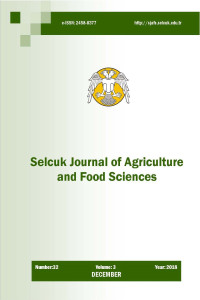Abstract
Poultry require high amounts of energy for feather development, meat and egg production. Since it is not possible to fill the whole of this energy starch, it becomes necessary to use oil in animal rations. Due to the increase in prices, there has been a significant decrease in the amount of oil used in the rations. However, in recent years it has become widespread to use palm oil in poultry feeding, which is cheaper in price and easier to supply and supply than other oils. Nearly half of the oil consumed in the world is palm oil. There are nearly 2 million tons of vegetable oil consumption per year in Turkey. Nearly 200.000 tons of this consumption is used in the feed production and this amount is increasing day by day. Compared to other vegetable oils, the high content of saturated fatty acids in palm oil and palm oil fractionated oils makes it more important to use this oil for human or animal feeding. Inactivating free radicals due to carotenoids and protecting the cells from oxidative stresses and destructive protection, high-level tocopherols acting on liver enzymes to lower blood cholesterol, genetic regulation, production of sex steroids, immune response and role in lung development and blood pressure lowering makes the palm oil exceptional. Especially rich in vitamin E, palm oil provides a significant advantage in poultry nutrition. In this review, the use of palm oil in poultry nutrition and its interactive role were examined.
Keywords
Palm oil Poultry Nutrition Tocotrienol Carotenoid Cholesterol
Abstract
Kümes hayvanları, tüy gelişimi, et ve yumurta üretimi için yüksek miktarda enerjiye gereksinim duyarlar. Bu enerjinin tamamının tane yemlerden karşılanması mümkün olmadığından kanatlı hayvan rasyonlarında yağ kullanılması zorunlu hale gelmektedir. Fiyatlarındaki artış nedeniyle rasyonlarda kullanılan yağ miktarlarında önemli oranlarda azalma meydana gelmiştir. Bununla birlikte son yıllarda diğer yağlara göre fiyatı daha ucuz, temin ve tedariki daha kolay olan palm yağının hayvan beslemede kullanılması yaygınlaşmaya başlamıştır. Dünyada tüketilen yağın yarısına yakınını palm yağı oluşturmaktadır. Türkiye’de yılda tüketilen 2 milyon tona yakın bitkisel yağın iki yüz bin tona yakın kısmı yem üretiminde kullanılmakta ve bu rakam her geçen gün artış göstermektedir. Diğer bitkisel yağlara göre palm yağı ve palm yağı fraksiyonu yağların doymuş yağ asit içeriğinin yüksek olması bu yağın gerek insan gerekse hayvan beslenmesinde kullanılmasını sorunlu hale getirmektedir. Diğer yandan içerdiği karotenoidlerden dolayı serbest radikalleri pasifize ederek hücreleri oksidatif stresten ve yıkımdan koruması, yüksek oranda sahip olduğu tokoferollerin karaciğer enzimleri üzerinde etki göstererek kan kolesterolünü düşürücü etki göstermesi, genetik regülasyonda, seks steroidlerinin üretiminde, immün yanıtın ve akciğerin gelişiminde rol oynaması ve kan basıncını düşürmesi gibi özellikler palm yağını ayrıcalıklı kılmaktadır. Özellikle vitamin E bakımından zengin olması palm yağının kanatlı hayvan beslemede kullanımında önemli avantaj sağlamaktadır. Bu derlemede, palm yağının kümes hayvanların beslenmesinde kullanımı ve interaktif rolleri incelenmiştir.
Details
| Primary Language | English |
|---|---|
| Subjects | Agricultural Engineering (Other) |
| Journal Section | Review Articles |
| Authors | |
| Publication Date | December 28, 2018 |
| Submission Date | August 18, 2017 |
| Published in Issue | Year 2018 Volume: 32 Issue: 3 |
Selcuk Agricultural and Food Sciences is licensed under a Creative Commons Attribution-NonCommercial 4.0 International License (CC BY NC).


